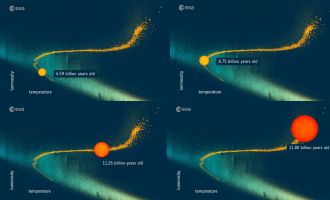The topic of the future and what will happen in it is a very philosophical issue, so you need to define what we mean by this term. In our case, it has to do with how long we will live and the sun will be present, and what important stages in this life will follow
The sun is the most famous star in space
Recently, the Solar Orbiter took the best-ever picture of the entire solar disk and corona. Its section can be seen in the entry image of this text. Below, another part of this image compares the size of the Earth and our star today. The original image is 83 Megapixels and was taken in far ultraviolet light. It corresponds to electromagnetic radiation with a wavelength of 17 nanometers, which far exceeds the capabilities of the Webb or even Hubble space telescope, which can observe in the visible near ultraviolet ranges.
But that doesn’t make a difference, because neither Webb nor Hubble will be able to observe the Sun. It is simply too bright for these telescopes. This task, in turn, is handled by the European Solar Orbiter probe, a specialized solar observatory, which orbits the Sun, observing its various parts, with a special focus on the polar regions.
Observations of the Sun are also made from Earth by solar telescopes. We can cause an artificial solar eclipse, analyze its composition, and even astronomers work in the field of solar seismology. But just by observing the sun, we won’t be able to tell anything about its age and future. What was required for this was the scientific breakthrough that we witnessed at the beginning of the twentieth century, when we got to know the world on an atomic and subatomic scale. And also very accurate observations of sun-like stars scattered around the galaxy, which we do to this day.
The stars and their evolutionary path are very predictable
Stars have a very interesting property. They can be predicted as long as we know their chemical composition and mass well. We can predict how long such a star will shine and what will happen to it at the end of its existence as an ordinary star. It’s completely different with humans. Even if the classroom includes children of the same weight and height, physical and intellectual abilities, and eats the same diet, the future of each may be determined differently. Yes, it can be assumed that according to interests, a certain person will continue his education in a certain direction, but what will happen next is not known until it happens.

Evolutionary path of Sun-like stars (age in billions of years)
Episodes of unexpected phenomena may also occur in a star’s evolution, but we are still able to account for these changes when describing a star’s history.
Stars live as long as the laws of nature allow for a certain mass and chemical composition. Unless something unexpected happens, identical stars have the same future
Basic knowledge of how stars are formed and how they evolve depending on mass is not, of course, anything new. This knowledge can be obtained even from school, as long as the teacher finds time for a course in the basics of astronomy.
A theory is a theory, but there is no such thing as an observation to prove it. These two things connect the human resource planner
However, modeling the evolution of stars is still only theoretical considerations, so there is nothing like comparing it with real data. These provide us with millions of stars in our sky. The more accurate the measurements, the better. Currently, the richest set of such data is the index based on the observations of the Gaia space telescope. We already have the third edition of the catalog, which includes data on mass, chemical composition, distance and brightness important to describe the evolution of a star.
The Gaia Space Telescope contains a database of 1.8 billion stars, several hundreds of millions of which have precisely determined their temperature, mass, age, color and minerality, and an additional several million from their precise chemical composition analysis.
Astronomers place this data on the so-called Hertzsprung-Russell (HR) chart. Each star has a precisely defined location on it. The graph combines properties of stars such as temperature, color, and observed and actual brightness. These data can be related to the spectral type (resulting from spectral observations of stars), the star’s mass and size, and its age. Corresponding lines can be plotted on the graph.

The Gaia data HR chart was created from the second (previous) edition of the Star Catalog. The main sequence is called the main sequence, that is, the positions of the stars during the main and longest phase of their evolution. The giant branch is a branch of the giants, that is, the evolving stars. White dwarfs are also present in this diagram because they still glow thermally. When it cools down, the white dwarfs move down the diagram
The Hertzsprung Russell scheme, independently developed in the second decade of the twentieth century by two scientists (Ejnar Hertzsprung and Henry Norris Russell), in its basic version combining the brightness of a star with its effective surface temperature, is one of the most important tools for analyzing observational data for stars. Both photometric and spectrophotometric. It is useful, among other things, in assessing the age of constellations
In theory, creating an HR diagram seems very simple. Practically speaking, the final set of data are columns of numbers that need to be plotted on a graph, but getting them takes hard work. At first a telescope, and then a team that is able, based on observations, to determine, among other things, the chemical composition of the stars, reducing measurement errors.
How do you discover sun-like stars at different stages of development?
During their lives, stars change their mass and chemical composition somewhat. However, their temperature and size fluctuate greatly, especially in the later stages of development. Therefore, it is easy to draw a diagram showing stars that are similar to the Sun but in different stages of their existence. If there are several such stars, then a curve can be superimposed on the points in the diagram, which will indicate the most likely path of evolution of the Sun.

We deduce the chemical composition from, inter alia, spectroscopic observations. Each element gives a specific absorption or emission spectrum, depending on whether it absorbs light (certain wavelengths or their bands) or emits it when excited. Stars can be classified based on this spectrum
The future of the sun depends on data from the Gaia telescope
Gaia data was analyzed by Orlagh Creevey of the French Riviera Observatory in collaboration with the 8 Gaia Data Format Unit. Evolutionary paths have been established for stars with different chemical compositions and masses, but the findings for the Sun are of particular interest to us.
and I know that The Sun is now about 4.57 billion years old We owe it to models of stellar evolution a certain mass, and this can be inferred from spectroscopic and astronomical observations. It is also useful to analyze the composition of matter that was formed around the same time as the Sun. These are rocks found on Earth, but also those that were brought from the Moon.
By analyzing the Gaia data described above, we know that this is about half the life of the Sun. This was actually predicted a long time ago, but as I mentioned, we now have the most accurate data set to prove it.
It also shows that the sun will continue to burn the hydrogen inside steadily for a long time. At the end of his life as an ordinary 8-billion-year-old starThe bright rays of the sun will gradually reach their maximum surface temperature. Then it expands, as the hydrogen continues to burn, but is already in the shell surrounding the core, and not in the core itself. At the same time, its surface temperature will decrease. About 10-11 billion years after its birth, the Sun will reach the stage of a red giant.


It is also general knowledge, but, again, I assert that it is better and can be better verified by observation.
The further stages of the Sun’s evolution have not been accurately described on the basis of Gaia data, but as far as we know, the Sun will continue to contract and re-expand as other burning processes begin, and eventually, after getting rid of its outer layers, will enter a dark white dwarf phase, albeit Hot, which will cool over time. The video above shows the change in the Sun’s position on the HR chart along with age information (expressed in billions of years), size animation (changes in size do not reflect reality) and color.
Why such notes at all? Why do we affirm what we already know?
The answer is simple. Not only out of sheer curiosity, but also to clarify the knowledge we already have about the evolution of stars, including our Sun. In order to better understand the processes occurring in the stars, the knowledge of which may be useful to mankind. It may seem strange, but in search of the most effective sources of energy, we are trying to imitate processes such as those that occur in stars to some extent.
The accuracy of the Gaia data and the graphs derived from it will also be useful when studying distant star clusters, including other galaxies. Their observations, precise distance measurements are necessary to accurately determine how our universe evolved.
In Gaia’s data, 5,863 stars almost identical to the Sun were also discovered. Both in terms of volume, surface gravity (volume and mass), chemical composition and age. Observing these stars for planets is an interesting challenge that will help answer the question of how likely it is to form planetary systems around stars like the Sun.
Source: ESA, inf. king

Echo Richards embodies a personality that is a delightful contradiction: a humble musicaholic who never brags about her expansive knowledge of both classic and contemporary tunes. Infuriatingly modest, one would never know from a mere conversation how deeply entrenched she is in the world of music. This passion seamlessly translates into her problem-solving skills, with Echo often drawing inspiration from melodies and rhythms. A voracious reader, she dives deep into literature, using stories to influence her own hardcore writing. Her spirited advocacy for alcohol isn’t about mere indulgence, but about celebrating life’s poignant moments.


![10 years with iron breaks records. The movie was a huge success. phenomenon [WIDEO]](https://www.moviesonline.ca/wp-content/uploads/2022/08/10-years-with-iron-breaks-records-The-movie-was-a.jpg)






